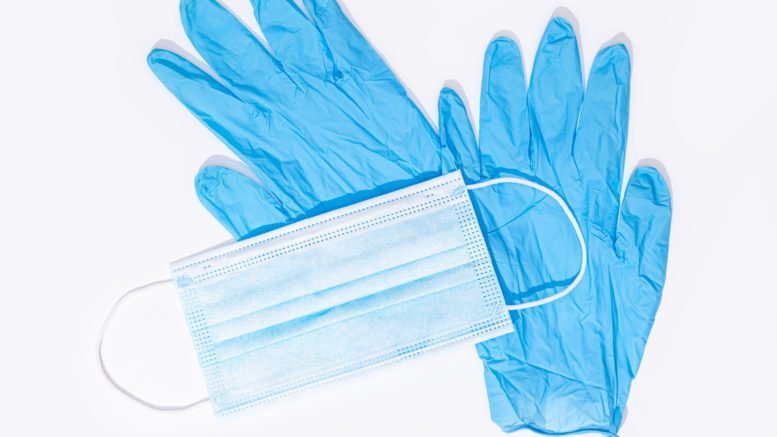The study by Neuwirth, et al. (2020) examines adherence observations of healthcare workers (HCWs) revealed deficiencies in the use of recommended personal protective equipment (PPE) among HCWs caring in COVID-19 and non-COVID-19 wards during the first period of the SARS-CoV-2 pandemic in a university hospital in Germany. They say adherence to wearing surgical face or FFP2-masks and disinfecting hands prior to donning and after doffing the PPE was significantly higher in COVID-19 wards; however, there was no total adherence of 100 percent in COVID-19 wards.
A prospective observational study was conducted in eight wards (two intensive-, two intermediate-, and four standard care units) at a university hospital in Cologne/Germany from February 27 to April 21, 2020. One intensive, one intermediate, and one standard care unit, all belonging to the Pulmonology Department and already experienced with infectious respiratory diseases before the COVID-19 pandemic, were exclusively dedicated to COVID-19 patients (hereinafter referred to as COVID-19 wards). Staff on these wards treated patients with respiratory infections on a regular basis and therefore frequently use the required PPE items. The remaining wards on which no COVID-19 patients were treated were called non-COVID-19 wards.
Based on national recommendations, a checklist of 18 items was compiled. It contained items to assess the processes of donning, wearing, and doffing of the PPE with the necessary work steps such as the required hand disinfection (HD). In COVID-19 wards, FFP2-masks had to be worn (only in rooms with SARS-CoV-2 positive patients). Adherence to the single and total process steps of donning and doffing of all the observed situations was calculated as the number of “yes” answers divided by sum of the number of “yes” and “no” answers. If an activity was carried out incorrectly, it was considered as “no." Adherence is considered sufficient if the percentage value is greater or equal to 80 percent. The observation results for the indication “no wearing of jewelry on hands and wrists” were inverted for the analysis due to their negative formulation.
Observations were performed by trained infection control nurses during patient care in the context of hand hygiene compliance observations, which are anchored in the legal requirements of the German Protection against Infection Act (§23 IfSG) and retrospectively evaluated. The correct wearing and fit of PPE were evaluated by the trained observer based on national recommendations. The observed HCW were aware of and agreed with the observation situations. The observations were made openly. At the beginning of the COVID-19 pandemic, a hygiene plan was developed and all HCW were trained on the use of the necessary PPE before the observations. In addition, a general obligation to wear SFM was introduced throughout the hospital. PPE had to be worn when treating COVID-19 patients as well as when treating patients with other infectious diseases, such as multi-resistant pathogens. At no time during the observation period was there a lack of protective equipment at the observing COVID-19 and non-COVID19 wards.
Chi-square test was used as appropriate. The Chi-square test could only be calculated if the expected cell frequencies of one or more cells were greater than 5. The Phi value was calculated as a measure of the effect strength.
During the study period, 127 situations requiring PPE were observed in 87 nurses, 22 physicians, and 18 other employees (93 females; 34 males) (several multiple observations).
A total of 79 observations [intensive (N = 40), intermediate (N = 38), standard care units (N = 1)], which included 776 process steps, were performed on COVID-19 wards and 47 observations [intensive (N = 18), intermediate (N = 6), standard care units (N = 23)] with 410 process steps on non-COVID-19 wards.
The results of the observations showed a significantly higher overall adherence for COVID-19 wards experienced with respiratory tract infections compared to non-COVID-19 wards, especially with regard to hand hygiene and donning of PPE.
On the level of the individual process steps with regard to the indications of hand hygiene, COVID-19 wards showed significantly higher adherence rates for the indications “no wearing of jewelry on hands and wrists”, “HD before donning PPE”, and “final HD at the end of the doffing process."
For the donning of PPE, significantly higher adherence rates were also found in the COVID-19 wards for the indications “correct donning of SFM/FFP2”, “correct removal of SFM/FFP2”, “final HD”, and “correct fit of SFM and FFP2 and additionally fit test of FFP2." Thereby, the indication “correct fit of SFM and FFP2 and additionally fit test of FFP2” showed the lowest adherence overall.
For the doffing of PSA, no significant difference in total adherence between COVID-19 and non-COVID-19 wards could be observed. The COVID-19 wards showed a significantly higher adherence rate only for the single indication “correct doffing of SFM/ FFP2 masks."
Reference: Neuwirth MM, et al. Adherence to personal protective equipment use among healthcare workers caring for confirmed COVID-19 and alleged non-COVID-19 patients. Antimicrobial Resistance & Infection Control. Vol. 9, No. 199. 2020.

Be the first to comment on "Researchers Examine Adherence to PPE Among HCWs Caring for Confirmed COVID-19 and Alleged Non-COVID-19 Patients"